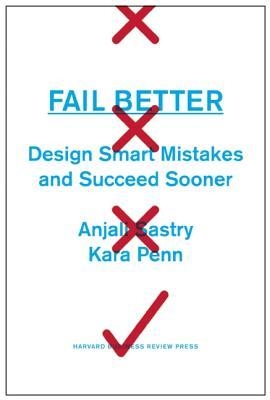
“Fail Better: Design Smart Mistakes and Succeed Sooner” by Anjali Sastry and Kara Penn (Harvard Business Review Press, $30.)
Innovation fuels the future, but failures are inevitable because actions and outcomes are separated by time and things beyond your control. The authors’ “Fail Better” approach systematizes project development and management to include learning experiences and uncovering insights every step of the way. Their three-step approach makes missteps work for you.
1. Launching your project requires the right groundwork. Forget the complicated project plan because the devil (i.e. lack of clarity) hides in its details. Instead, keep it “simple, supple and scrappy.”
Being concise ensures that you delve deeply into the problem’s causes , not its symptoms. A concise statement of the problem also contains the specifics of those affected by the process (mostly internal stakeholders) and the outcome (external and internal) stakeholders, a prioritized list of deliverables and ways to measure progress.
With that as a base, you can develop key indicators relative to deliverables; these fuel ideas when outcomes differ from expectations. The indicators also allow for rethinking and reprioritizing deliverables.
2. Don’t repeat processes; refine them. Think of the project’s activities as learning-by-doing, rather than following prescribed protocol.
In a way, learning by doing treats each step as a test of hypotheses. During this ongoing testing process, feedback loops promote opportunities “to mine useful guidance and learning.” As learning by doing unfolds, team members think ahead and make better decisions based upon test results.
3. Using knowledge-sharing to identifying and embed the learning in the organization.
Assemble an archive of all projects that includes timelines identifying deliverables, priorities, team construction, actions and outcomes. Because no project ever goes as planned, the archive should include shifts within projects and the reasons behind them. Encourage the use of the archives by those involved with current projects, and when developing the groundwork for future projects.
Key takeaway: “The right kind of failure instructs, refines and improves ideas, work products, skills, capacities and teamwork.”
“Hello Stay Interviews, Goodbye Talent Loss — A Manager’s Playbook” by Beverly Kane and Sharon Jordan-Evans (Berrett-Koehler Publishers, $17.95).
When business owners look at their income statements, they see only revenue and expenses; they don’t see the hidden cost of turnover.
According to a recent study by Manpower Group, replacing an entry-level employee costs about $6,000; the cost of replacing a midlevel manager could reach upwards of $60,000.
The costs relate to conducting a search, lost productivity as others shoulder the load and the cost of training a newbie. Then there’s the morale cost that can’t be measured in dollars, but which could result in more turnover.
Too often, managers don’t realize a valued employee is looking until notice is given. Then, during the exit interview, they ask, “What can I do to keep you?” The authors believe that variations of the question should have been asked and answered while the employee was on the job.
Stay interviews are conversations between the manager and employees that:
1. Provide an opportunity to find out more about what’s important to employees
2. Tell employees that their contributions are valued.
When employees know that management listens to them, they become more engaged in their work, and less likely to jump ship.
Open-ended questions are the tools of the stay interview because they let employees express themselves. Some good ones are:
▶“What did you learn this year about yourself?”
▶ “What can I do to support your career goals?”
▶ “What makes for a great day at work?
The bottom line: Stay interviews identify what managers need to do to keep valued employees.
Jim Pawlak is a nationally syndicated reviewer of business books.